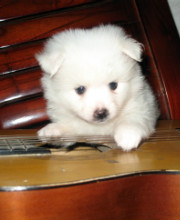| 图片: | |
|---|---|
| 名称: | |
| 描述: | |
- 2013年3月粤读片会---右肾中上部占位
| 性别 | 女 | 年龄 | 52岁 | 临床诊断 | 右肾癌? |
|---|---|---|---|---|---|
| 一般病史 | 腰部不适半个月,发现右肾肿物10余天。 | ||||
| 标本名称 | 右肾 | ||||
| 大体所见 | 半月前无明显诱因出现右腰部及右上腹隐痛,可自行缓解,十余天前因“胃部不适”到当地医院就诊,考虑“轻度萎缩性胃炎伴溃疡,部分轻度不典型增生”,CT示右肾中上部占位,4.5 cm×3.7cm×4.5cm,腹膜后多发小淋巴结,较大者0.9 cm×0.7 cm。 大体:送检肾组织大小为10 cm×6 cm×4 cm,切面见肿物大小为3 cm×3 cm×3 cm,多彩状,累及肾被膜。 | ||||

名称:图1
描述:A252

名称:图2
描述:A253

名称:图3
描述:A254

名称:图4
描述:A255

名称:图5
描述:A256

名称:图6
描述:A257

名称:图7
描述:A258

名称:图8
描述:A259

名称:图9
描述:A260

名称:图10
描述:A261

名称:图11
描述:A262

名称:图12
描述:A263

名称:图13
描述:A264

名称:图14
描述:A265

名称:图15
描述:A266

名称:图16
描述:A267

名称:图17
描述:A268

名称:图18
描述:A269

名称:图19
描述:A270

名称:图20
描述:A271

名称:图21
描述:A272

名称:图22
描述:A273

名称:图23
描述:A274

名称:图24
描述:A275

名称:图25
描述:A276

名称:图26
描述:A277

名称:图27
描述:A278

- 重归学生时代!
这例有明确的嫌色细胞癌,问题主要在于那些细胞较小偏嗜酸性的是嫌色细胞癌还是混合的嗜酸性腺瘤
混合的肾细胞肿瘤确实存在,尤其是BHD综合征患者,但是散发型的无BHD综合征患者仍然还是可以有混合的成分:
Sporadic hybrid oncocytic/chromophobe tumor of the kidney: a clinicopathologic, histomorphologic, immunohistochemical, ultrastructural, and molecular cytogenetic study of 14 cases.
Source
Department of Pathology, National University Hospital System, Singapore, Singapore.
Abstract
Hybrid oncocytic/chromophobe tumors (HOCT) of the kidney have been described in patients with Birt-Hogg-Dubé syndrome (BHD) and in association with renal oncocytosis without BHD. HOCT in patients without evidence of BHD or renal oncocytosis is exceedingly rare, and these cases have been poorly characterized. We have identified and studied 14 cases of HOCT from previously diagnosed renal oncocytomas (398 cases) and chromophobe renal cell carcinomas (351 cases) without evidence of BHD or renal oncocytosis. Immunohistochemical, ultrastructural, and molecular genetic studies analyzing numerical chromosomal changes, loss of heterozygosity for chromosome 3p, and mutation status of VHL, c-kit, PDGFR, and folliculin (FLCN) genes were performed. HOCTs were identified in nine men and five women (age range 40-79 years). The size of tumors ranged from 2 to 11 cm. All tumors displayed a solid alveolar architecture and were composed of cells with abundant granular eosinophilic oncocytic cytoplasm with perinuclear halos. Occasional binucleated neoplastic cells were present, but irregular, hyperchromatic, wrinkled (raisinoid) nuclei were absent. The cytoplasm contained numerous mitochondria of varying sizes, but only sparse microvesicles with amorphic lamellar content were found. Tumors were positive for CK7 (12/14), AE1-AE3 (14/14), anti-mitochondrial antigen (14/14), E-cadherin (11/13), parvalbumin (12/14), and epithelial membrane antigen (14/14). Tumors were generally negative for racemase, CK20, CD10, and carboanhydrase IX. Interphase fluorescence in situ hybridization revealed multiple chromosomal losses and gains with a median of four (range 1-9) chromosomal aberrations per case. Monosomy of chromosome 20 was common and found in 7 of 14 cases. Monosomy of chromosomes 6 and 9 was present in 4 of 14 cases each, of which two cases displayed monosomy for both chromosomes 6 and 9. Polysomy of chromosomes 10, 21, and 22 was found in 4/14 cases each, of which one case displayed polysomy for all these three chromosomes. No pathogenic mutations were found in the VHL, c-kit, PDGFR, and folliculin (FLCN) genes. (1) We have shown that hybrid oncocytic/chromophobe tumors of the kidney do occur, albeit rarely, outside the Birt-Hogg-Dubé syndrome and without associated renal oncocytosis. (2) These tumors constitute a relatively homogenous group with histomorphologic features of both chromophobe renal cell carcinoma and renal oncocytoma. (3) Sporadic hybrid oncocytic/chromophobe renal tumors are characterized by multiple numerical aberrations (both mono- and polysomies) of chromosomes 1, 2, 6, 9, 10, 13, 17, 21, and 22 and lack of mutations in the VHL, c-kit, PDGFRA, and FLCN genes. (4) The tumors seem to behave indolently as no evidence of malignant behavior was documented in our series, although admittedly, the follow-up was too short to fully elucidate the biological nature of this rare neoplasm. At worst, these tumors could have a low malignant potential, which only can be found out with longer follow-up.
BHD综合征肾脏肿瘤:
Renal tumors in the Birt-Hogg-Dubé syndrome.
Source
Urologic Oncology Branch, Center for Cancer Research, National Cancer Institute/NIH, Bldg. 10 Rm. 2N212, Bethesda, MD 20892, USA.
Abstract
Birt-Hogg-Dubé (BHD) syndrome is an autosomal dominant genodermatosis characterized by the development of small dome-shaped papules on the face, neck, and upper trunk (fibrofolliculomas). In addition to these benign hair follicle tumors, BHD confers an increased risk of renal neoplasia and spontaneous pneumothorax. To date, there has been no systematic pathologic analysis of the renal tumors associated with this syndrome. We reviewed 130 solid renal tumors resected from 30 patients with BHD in 19 different families. Preoperative computed tomography scans demonstrated a mean of 5.3 tumors per patient (range 1-28 tumors), the largest tumors averaging 5.7 cm in diameter (+/- 3.4 cm, range 1.2-15 cm). Multiple and bilateral tumors were noted at an early age (mean 50.7 years). The resected tumors consisted predominantly of chromophobe renal cell carcinomas (44 of 130, 34%) or of hybrid oncocytic neoplasms that had areas reminiscent of chromophobe renal cell carcinoma and oncocytoma (65 of 130, 50%). Twelve clear cell (conventional) renal carcinomas (12 of 130, 9%) were diagnosed in nine patients. These tumors were on average larger (4.7 +/- 4.2 cm) than the chromophobe (3.0 +/- 2.5 cm) and hybrid tumors (2.2 +/- 2.4 cm). Microscopic oncocytosis was found in the renal parenchyma of most patients, including the parenchyma of five patients with evidence of clear cell renal cell carcinoma. Our findings suggest that microscopic oncocytic lesions may be precursors of hybrid oncocytic tumors, chromophobe renal cell carcinomas, and perhaps clear cell renal cell carcinomas in patients with BHD syndrome. Recognition by the pathologist of the unusual renal tumors associated with BHD may assist in the clinical diagnosis of the syndrome.
 阿克曼10版怎么说?嫌色细胞癌和嗜酸性腺瘤的关系有时候还真说不清,下面的6点包括了楼上各位的一些意见。
阿克曼10版怎么说?嫌色细胞癌和嗜酸性腺瘤的关系有时候还真说不清,下面的6点包括了楼上各位的一些意见。
我不觉得这例是转移癌+嫌色细胞癌
The histogenetically most interesting and practically most important issue with chromophobe renal cell carcinoma is that of its relationship with oncocytoma. We strongly suspect that these two tumors are closely related, based on the following observations:









































